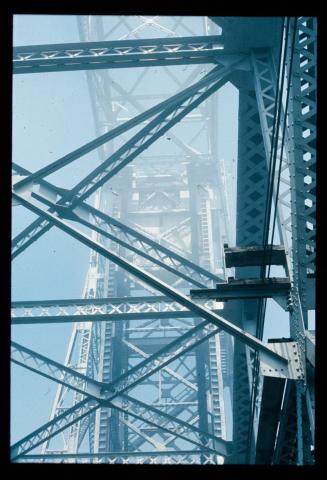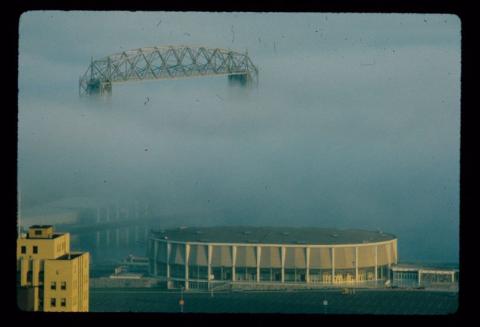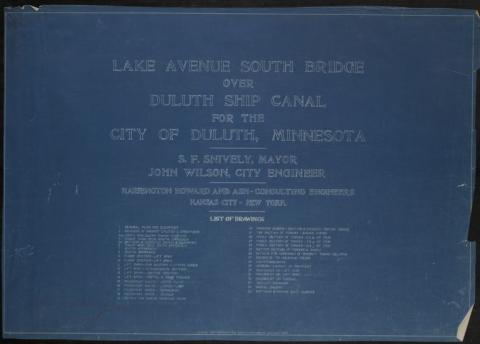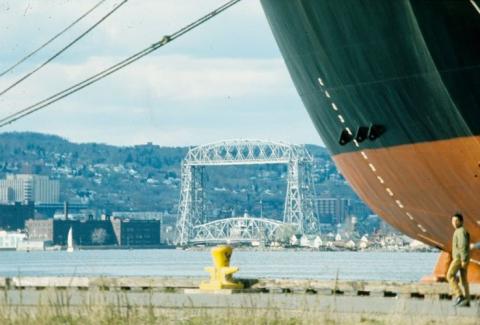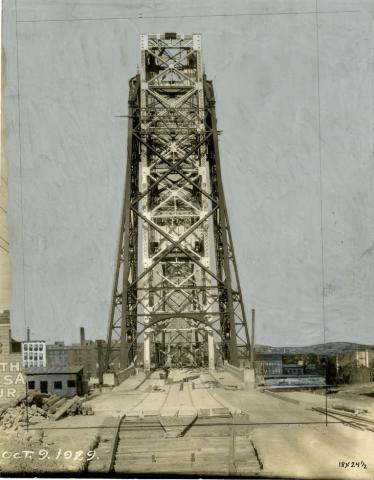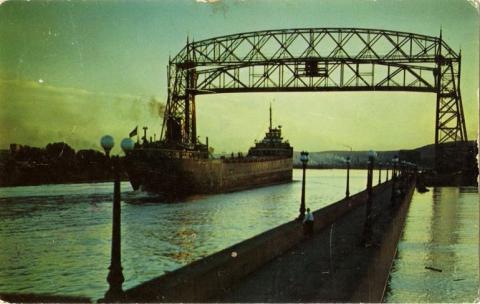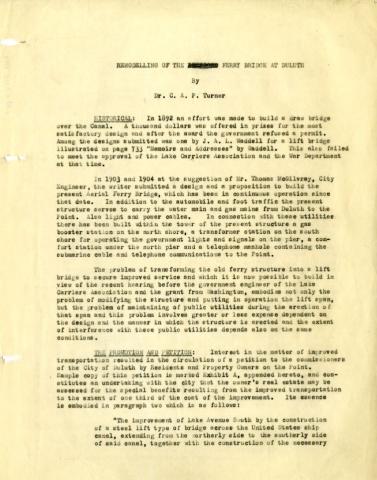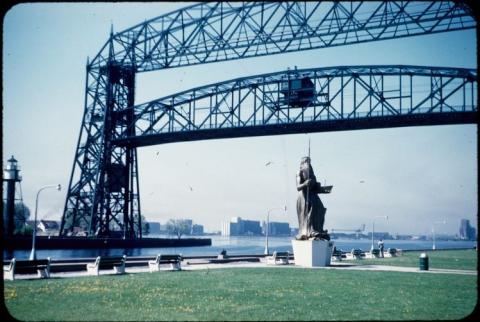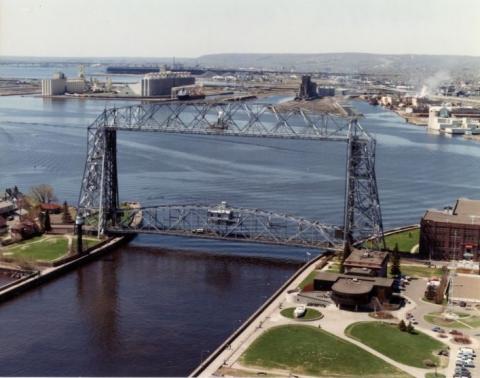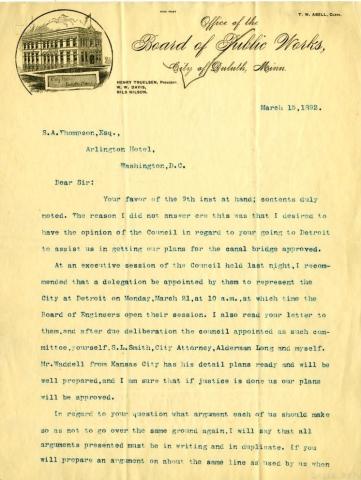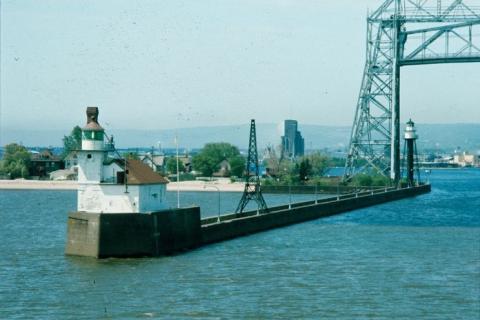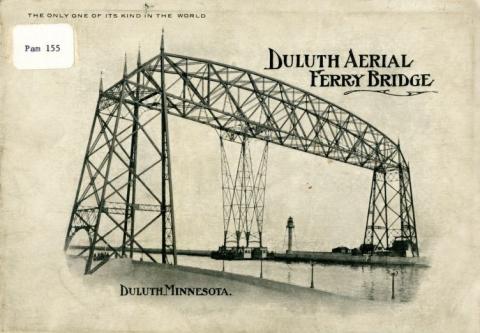Primary Source Set
by Abigail Raper, Intern, Minnesota Digital Library
Tired of ferrying and temporary bridges across the man-made ship canal that cut through Minnesota Point, the city of Duluth hosted a bridge design competition in 1891 to connect the mainland to the Park Point neighborhood. Although a Milwaukee firm won the $1,000 prize, their double-leveled drawbridge was too expensive to build. In second place was someone who became known as the father of modern vertical lift bridges—John Alexander Low Wadell. His plan involved a truss suspended between two towers. Powered by a motor engine, the platform can lift to accommodate boats, vehicles, and pedestrians. However, the U.S. War Department declined this build, fearing it would block the Lake Superior canal.
While Wadell later constructed his bridge in Chicago in 1894, Duluth turned to Thomas McGilvray and C.A.P. Turner for another idea. Inspired by French architect, Ferdinand Arnodin, they assembled a transfer bridge, a hybrid structure incorporating a ferry in its design. Completed in 1905, it used a gondola suspended from inverted steel towers with a truss underneath to help pedestrians and boats move along. This was the first of two transfer bridges built nationally, with both eventually dismantled due to safety concerns. Duluth opted for a vertical lift bridge after all in 1929 as the transfer bridge proved inadequate to support the influx of population and tourism. They modified McGilvray’s original structure, installing an elevated roadway, lengthened towers, and new counterweight support. Its impressive 180-foot clearance, 386-foot span, and 900-ton heft can still be seen today.
The vertical lift bridge has had four rehabilitations since 1930, including replacing the operator’s house, adding and repairing structural elements, cleaning, and repainting. Cables are replaced every eighteen years. During 1999’s rehabilitation, Ryan Beamer gathered the discarded scrap rivets and later molded them into miniature bridges as souvenirs. Until 2010, the bridge lifted around 40 times daily, seven days a week. More recently, to minimize traffic and prolong the structure’s life, the U.S. Coast Guard approved a more limited schedule to prioritize larger freights and emergency boats.
In 1973, Duluth’s vertical lift bridge was added to the National Register of Historic Places due to its significant role in the life, landscape, and commerce of the Twin Ports region.
Discussion Questions & Activities
1) Scavenger hunt! Find the aerial lift bridge on the “Map of Duluth” (sixth image above). Then, investigate the surrounding area. Do you recognize other places that support what was mentioned about the bridge?
2) Pick a blueprint from the “Lake Avenue South Bridge” (third image above) and reflect on what you see. What is written and drawn? How does this help understand the bridge?
3) After reading the article, “A Tale of Two Cities” or a related article, how does the bridge move? Where does it move from? What is the bridge made of?
4) In three to five words, explain why the bridge is important.
5) Using listed sources, read about John A.L. Waddell and Thomas McGilvray. Why did their designs appeal to the city? What personal traits do you think they had that helped in their success?
6) What primary source images deepen comprehension with the summary and additional sources? Pick at least two.
7) Is there another way this bridge could be built to help Duluth? Giving students paper and coloring supplies, allow them to make a blueprint of their own bridge—creativity or technicality encouraged! How does it work? How would this solve Duluth’s problem with the Duluth Ship Canal?
eLibrary Minnesota Resources (for Minnesota residents)
1) “BRIEF: Fewer Lifts for Duluth Lift Bridge Approved.” Duluth News-Tribune, 20 May 2011. EBSCOhost (accessed 29 June 2023).
2) "Duluth's Lift Bridge, Training Programs to Benefit from Federal Aid." TCA Regional News, Dec 22, 2022. ProQuest (accessed 29 June 2023).
3) "Famed Aerial Lift Bridge in Duluth is Up for Overhaul." Milwaukee Journal Sentinel, Sep 21, 1999, pp. 5. ProQuest (accessed 29 June 2023).
4) Oakes, Larry. "They Saw Two Ships Come Sailing Up—Then One Pulled a U-Turn." Star Tribune, May 26, 2008. ProQuest (accessed 29 June 2023).
5) Renalls, Candace. "You can Own a Piece of Duluth's Aerial Lift Bridge," McClatchy–Tribune Business News, Oct 19, 2009. ProQuest (accessed 29 June 2023).
Additional Resources for Research
1) “Aerial Lift Bridge in Duluth MN: An Intriguing History.” Go Duluth MN, 10 Mar. 2015 (accessed 5 June 2023).
2) “Bridge Cam.” Duluth Harbor Cam (accessed 29 June 2023).
3) “Duluth’s Aerial Lift Bridge.” Exploring the North Shore, 27 June 2022 (accessed 5 July 2023)
4) “Historic Bridges: Duluth Aerial Lift Bridge.” MnDOT (accessed 29 June 2023).
5) “November 25, 1957: Death of Engineer Thomas McGilvray.” Zenith City Press, 27 Oct. 2022 (accessed 5 July 2023).
6) “The Difference Makers: John Alexander Low Waddell.” Portfolio Panynj, 8 Oct. 2015 (accessed 5 July 2023).
7) "Thomas F. McGilvray Papers." University of Minnesota Archival Collections Guides, col. S4484 (accessed 5 July 2023).
8) Brown, Jeff L. “A Tale of Two Cities: Chicago, Duluth, and the Birth of the Modern Vertical Lift Bridge.” Civil Enginerring Magazine Archive, vol. 83, no. 6, June 2013, pp. 42–45. ASCE Library (accessed 29 June 2023).
9) Cartwright, R. L. "Duluth Ship Canal Opening, 1871." MNopedia, Minnesota Historical Society (accessed 5 July 2023).
Published onLast Updated on
